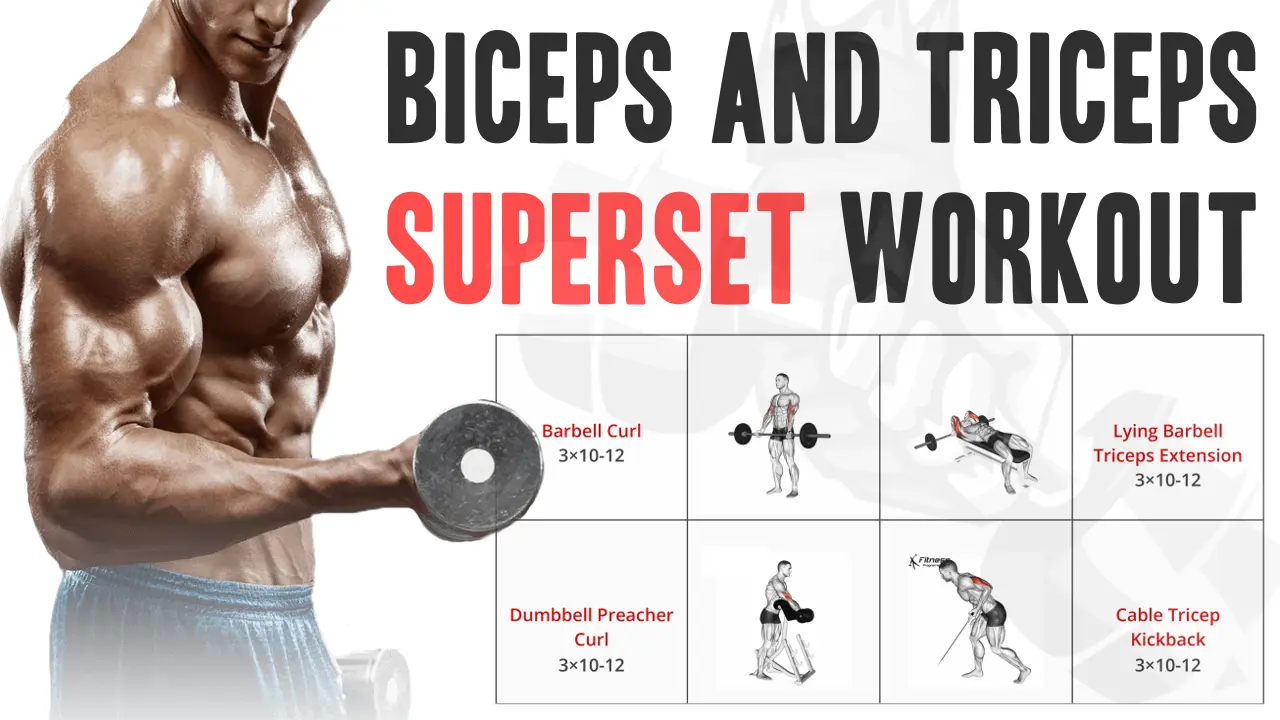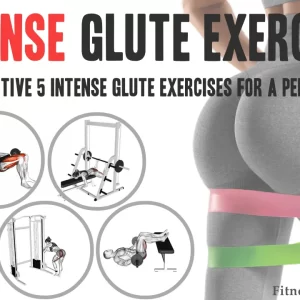Contents
- Introduction to Biceps and Triceps Superset Training
- Benefits of Biceps and Triceps Superset Workout
- Disadvantages of Supersets:
- When to Avoid Supersets:
- How to Perform Superset Training:
- 4 Effective Biceps and Triceps Superset Workouts
- Customizing Supersets for Your Arm Goals
- Sample Superset Workouts Based on Goals:
A biceps and triceps superset workout is a specialized strength training routine designed to target and strengthen the muscles in your arms effectively. It involves performing pairs of exercises that focus on the two primary muscle groups in your arms: the biceps and triceps.
In this workout, you alternate between exercises that work the biceps and triceps, creating a balanced and intense training session for your arms. It’s a popular choice among bodybuilders looking to build well-rounded arm muscles and can be customized with a variety of exercises and rep ranges to suit their individual goals.
Are you ready to take your arm gains to the next level? If so, you’re in the right place.
Introduction to Biceps and Triceps Superset Training
Supersets are a powerful training technique that involves performing two exercises back-to-back with little to no rest in between. These exercises can target the same muscle group (agonist supersets) or opposing muscle groups (antagonist supersets). The goal of supersets is to increase the intensity of your workout, save time, and provide various benefits such as muscle hypertrophy, improved muscular endurance, and enhanced fat burning.
Two basic types of supersets:
1. Agonist Supersets
Agonist supersets involve pairing exercises that target the same muscle group, such as doing two biceps exercises back-to-back. This approach increases the muscle activation and recruitment within that specific area, leading to more targeted and intense muscle stimulation. Performing these exercises consecutively without resting in between not only increases the intensity but also encourages muscle growth and endurance.
Example: Barbell Curl – Dumbbell Curl
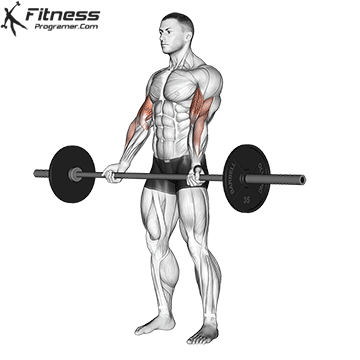 |  |
The main objective behind incorporating supersets, where two exercises are performed consecutively, is to maximize muscle fatigue within a specific muscle group. However, it’s important to note that while supersets can be highly effective, they can also lead to quicker fatigue compared to traditional workouts. This increased fatigue may necessitate longer recovery periods between workouts (1).
2. Antagonist Supersets
One of the most popular superset approaches is the antagonist superset. This involves pairing exercises that target opposing muscle groups, such as biceps and triceps. The advantage here is that while one muscle group is working, the opposing muscle group can rest, allowing you to maintain a high level of intensity throughout the superset. This type of superset is often used to save time during workouts and promote balanced muscle development.
Example: One-arm Cable Curl – Cable Kickback
 | 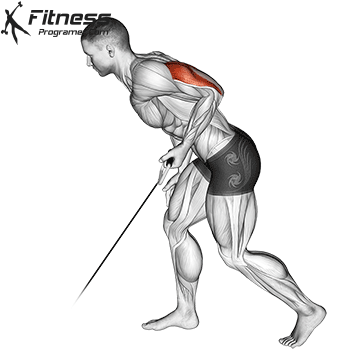 |
Benefits of Biceps and Triceps Superset Workout
Why should you consider combining biceps and triceps workouts in a ”antagonist” superset?
1- Pump:
In an antagonist superset, you alternate between biceps and triceps exercises with minimal rest. This constant back-and-forth stimulates a rapid and significant increase in blood flow to both muscle groups. The influx of blood into the muscles leads to their temporary expansion and swelling. This phenomenon, known as “the pump,” results in a tight, full feeling in your biceps and triceps.
2- Muscle Hypertrophy:
While the pump is temporary and typically subsides after your workout, it contributes to muscle hypertrophy over time. The reduced rest between exercises keeps both the biceps and triceps under constant tension. Muscle growth, or hypertrophy, is stimulated when muscles are subjected to prolonged tension, causing them to adapt and grow in response to the workload. This higher training intensity is effective in promoting muscle growth in a short period of time.
3- Vascularity:
The enhanced pump can also increase vascularity, making the veins in your arms more pronounced. This can add an aesthetic dimension to your arm development, giving your arms a more chiseled appearance.
4- Balanced Muscle Development:
Balancing opposing muscle groups in an antagonist superset is crucial for overall muscle development.By training both the biceps and triceps together, you ensure that one muscle group isn’t dominating the other.
Disadvantages of Supersets:
- Increased Fatigue: The shorter rest intervals between exercises can lead to quicker fatigue. This can be advantageous for muscle growth but may limit the amount of weight you can lift.
- Form Sacrifice: Rushing through supersets can lead to compromised form, which increases the risk of injury. It’s crucial to prioritize proper technique.
- Reduced Strength Output: Supersets may not be ideal for maximal strength development since they often involve lifting submaximal weights.
- Overtraining Risk: Overusing supersets without adequate rest and recovery can lead to overtraining, which can result in injuries and stalled progress.
When to Avoid Supersets:
- Inadequate Recovery: If you haven’t fully recovered from a previous workout, doing supersets might not be the best idea. Overtraining can lead to injury and hinder progress.
- Advanced Training: Beginners may not benefit as much from supersets since they require a solid foundation of basic strength and form. It’s often more beneficial to focus on building a strong base first.
How to Perform Superset Training:
Select Your Superset: Choose from the superset options provided below based on your fitness level and goals.
Unilateral Exercise and Muscle Balance: Unilateral exercises, which work one limb at a time, are essential for muscle balance and functional strength. When doing biceps and triceps supersets, consider alternating between exercises that target each arm independently. This helps identify and correct any strength or size imbalances between your arms, ensuring they both develop evenly. (Why Is My Right Bicep Bigger Than My Left?)
Warm-Up: Start with a brief warm-up to prepare your muscles for the workout. This can include light cardio and dynamic stretching.
Sets and Repetitions (Reps): A common approach is to perform 3-4 sets of each superset. However, you can adjust this based on your experience level, available time, and workout intensity. Repetitions per set typically range from 8 to 12, but again, this can be tailored to your preferences and goals. To maximize the pump during an antagonist superset, aim for high-repetition sets with moderate weight.
Rest Period: After finishing one superset (both exercises), take a brief 30 to 90 second rest before moving on to the next superset.
4 Effective Biceps and Triceps Superset Workouts
Option 1: Dumbbell Only Biceps and Triceps Superset Workout
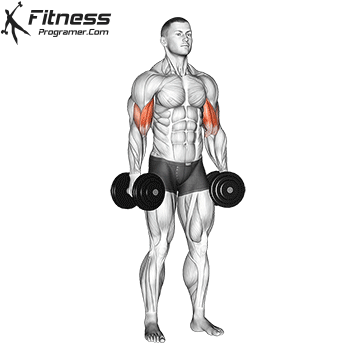 Double Arm Dumbbell Curl 3×10-12 |  Bent Over Triceps Kickback 3×10-12 |
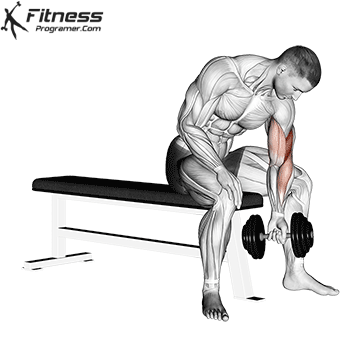 Concentration Curl 3×10-12 | 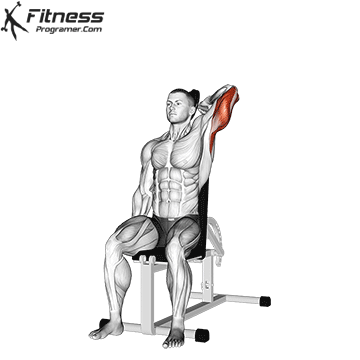 Dumbbell Triceps Extension 3×10-12 |
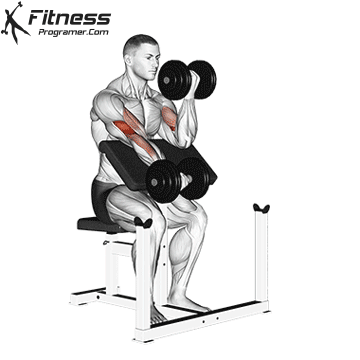 Dumbbell Alternating Preacher Curl 2×10-12 |  Dumbbell Alternating Triceps Extension 2×10-12 |
Option 2: Barbell Only Biceps and Triceps Superset Workout
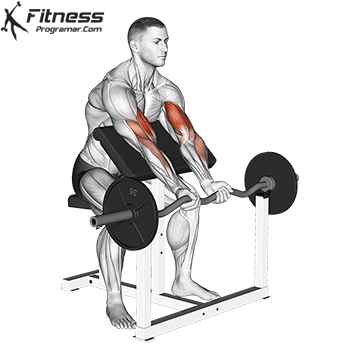 EZ Bar Preacher Curl 3×10-12 |  EZ-Bar Triceps Extension 3×10-12 |
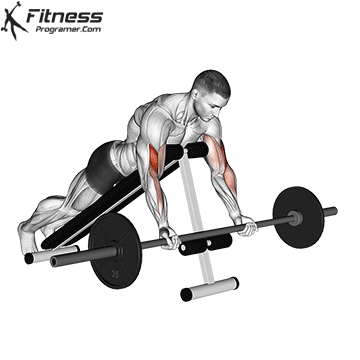 Prone Incline Barbell Curl 3×10-12 |  Decline Close-Grip Skull Crusher 3×10-12 |
Option 3: Biceps and Triceps Superset Training with Cables
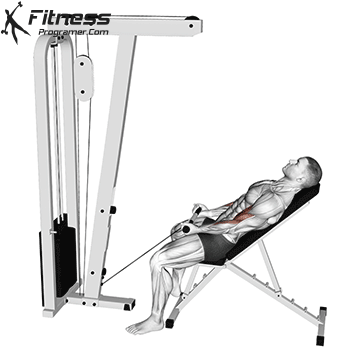 Cable Incline Biceps Curl 3×10-12 | 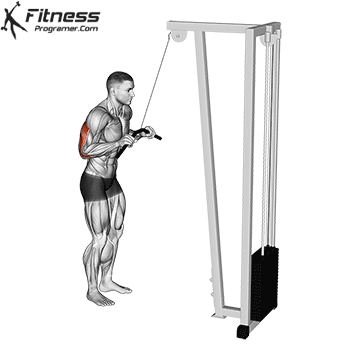 Cable Push-Down 3×10-12 |
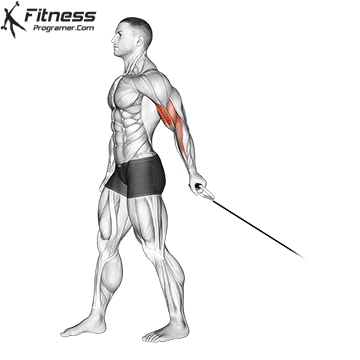 One Arm Cable Curl 3×10-12 | 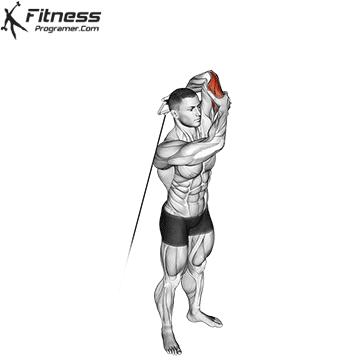 One-Arm Overhead Triceps Extension 3×10-12 |
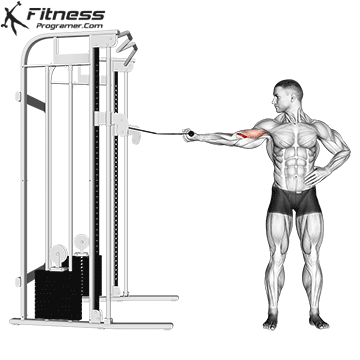 High Cable Single Arm Bicep Curl 2×10-12 | 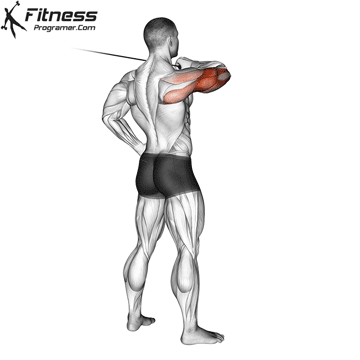 High Cable Rear Drive 2×10-12 |
Superset Option 4: Well-Rounded Arm Superset Workout
 Barbell Curl 3×10-12 |  Lying Barbell Triceps Extension 3×10-12 |
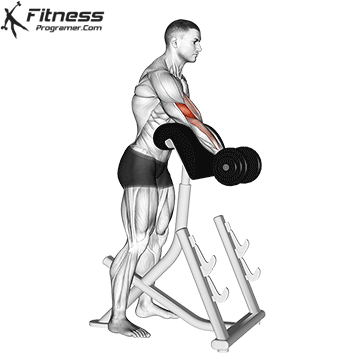 Dumbbell Preacher Curl 3×10-12 |  Cable Tricep Kickback 3×10-12 |
 Barbell Wrist Curl 3×10-12 |  Reverse Wrist Curl 3×10-12 |
Customizing Supersets for Your Arm Goals
Supersets can be a powerful tool for sculpting your arms, but to maximize their effectiveness, it’s essential to tailor your workouts to your specific goals. Whether you aim to build size, increase strength, or enhance muscle endurance, designing your own superset workouts allows you to create a training regimen that aligns with your objectives. Here’s how you can customize supersets for your arm goals:
1. Determine Your Arm Training Goals:
Before you start designing your superset workouts, identify your primary arm training objectives. Common goals include:
- Muscle Hypertrophy (Size): If you want to build bigger arms, focus on exercises that target both biceps and triceps. Higher rep ranges (8-12 reps) and moderate weights are typically effective.
- Strength: If your goal is to increase arm strength, prioritize compound movements like close-grip bench presses, barbell curls, and weighted dips. Use heavier weights with lower reps (4-6 reps).
- Muscular Endurance: For improved muscle endurance, select exercises that involve continuous movement and higher rep ranges (15+ reps). Cable curls and triceps pushdowns can be excellent choices.
2. Volume and Repetitions:
The number of sets and repetitions you perform in each superset can vary based on your goals:
- Hypertrophy (Size): Aim for 3-4 sets of 8-12 repetitions per exercise in the superset.
- Strength: Perform 4-5 sets of 4-6 repetitions per exercise in the superset.
- Endurance: Execute 3-4 sets of 15+ repetitions per exercise in the superset.
3. Progression:
To continuously challenge your muscles and make progress, consider these techniques:
- Progressive Overload: Gradually increase the weights or resistance over time to ensure your muscles adapt and grow.
- Variation: Regularly switch up exercises and angles to prevent plateaus and stimulate different muscle fibers.
- Rest Intervals: Adjust the rest periods between exercises or supersets to modify the intensity of your workouts.
4. Rest Periods:
In superset training, shorter rest periods keep your muscles engaged and your heart rate elevated. For hypertrophy and endurance goals, aim for 30-90 seconds between supersets. For strength goals, allow slightly longer rests, around 60-120 seconds.
Sample Superset Workouts Based on Goals:
For Strength:
Superset 1:
- Barbell Curl: 4 sets x 5 reps
- Close-Grip Bench Press: 4 sets x 5 reps
Superset 2:
- Weighted Chin up: 5 x 5
- Weighted Dips: 5 x 5
For Endurance:
Superset 1:
- Cable Curls: 3 sets x 15 reps
- Tricep Kickbacks: 3 sets x 15 reps
Superset 2:
- Diamond Push-Ups: 4 sets x 20 reps
- Bodyweight Triceps Dips: 4 sets x 20 reps
In summary
Incorporating both antagonist and agonist supersets into your biceps and triceps workout routine allows you to reap a range of benefits, from time efficiency and muscle balance to increased intensity and targeted muscle activation. Consider your individual goals and preferences when deciding which superset approach to use in your training sessions, and don’t hesitate to experiment with both to see what works best for you. By customizing your supersets to align with your objectives, you’ll be on your way to achieving the arms you’ve always desired.
References:
- Sports Med. 2021: No Time to Lift? Designing Time-Efficient Training Programs for Strength and Hypertrophy: PMID: 34125411
- Int J Environ Res Public Health. 2019 Dec; Maximizing Muscle Hypertrophy: A Systematic Review of Advanced Resistance Training Techniques and Methods PMID: PMC6950543
- Eur J Appl Physiol. 2017; The effects of traditional, superset, and tri-set resistance training structures on perceived intensity and physiological responses PMID: 28698987
- Muscle Damage and Muscle Activity Induced by Strength Training Super-Sets in Physically Active Men PMID: 27243916

